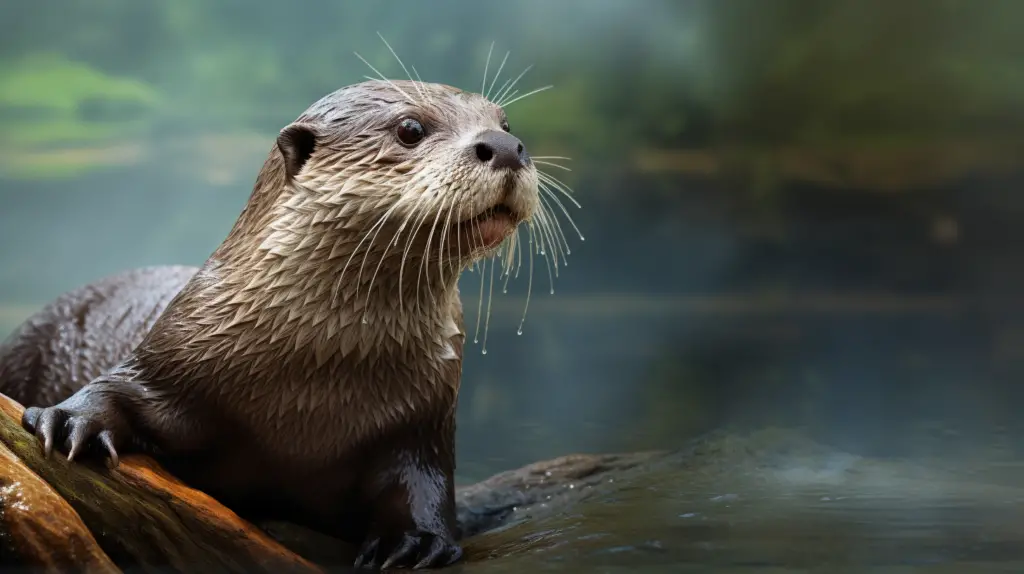The North American River Otter, also known as the Northern River Otter or Common Otter, is a captivating member of the Mustelidae family that incites much interest and intrigue among scientists and animal enthusiasts alike. Revered for their playful demeanor, intricate social structures, and remarkable adaptability, river otters embody a fascinating blend of cuteness and survival prowess.
Are otters dangerous to humans?
One common question people often have about these creatures is whether they pose any danger to humans. Generally, North American River Otters are not dangerous and do not pose a significant threat to human safety. They are often more afraid of humans than we are of them, and usually prefer to keep a safe distance. However, like any wild animal, they may become aggressive if they feel threatened or cornered. In August 2023, three women were injured after an otter attack while swimming in Jefferson River, with one woman receiving severe bites to her face and arms while the other two women received superficial wounds. Thus, it is essential to remember the importance of respecting their space and observing them from a safe distance.
Now that we’ve established their basic nature, let’s delve into 25 intriguing facts about the North American River Otter, an enchanting creature that gracefully thrives in water and on land.
1. North American River Otters are highly adaptable creatures found in a variety of freshwater environments such as rivers, lakes, marshes, and coastal shorelines.
2. Otters are mainly nocturnal, but they may also be active during dawn and dusk (crepuscular) and sometimes during the day.
3. The body of a North American River Otter can measure from 66 to 107 cm in length, not including the tail, which can add an additional 30 to 40 cm.
4. The weight of a mature North American River Otter can range between 5 and 14 kilograms.
5. The river otter’s dense fur not only keeps it warm but also aids in buoyancy.
6. They are incredibly agile swimmers, capable of reaching speeds up to 6 miles per hour underwater.
7. River otters can hold their breath for as long as 8 minutes while diving.
8. North American River Otters have a highly developed sense of sight and smell that assists them in locating prey both underwater and on land.
9. The diet of a river otter mainly comprises fish, but they also eat crustaceans, amphibians, birds, and small mammals when available.
10. Otters use a variety of vocalizations, from whistles and buzzes to screams and chuckles, to communicate with each other.
READ MORE: 25 Interesting Facts About the Pink Dolphin, aka the Amazon River Dolphin
11. River otters have a lifespan of approximately 8 to 9 years in the wild, but they can live up to 21 years in captivity.
12. They exhibit a playful behavior called ‘tobogganing’, where they slide down slopes of snow or mud, seemingly for fun.
13. North American River Otters are known to use tools, often utilizing rocks to crack open hard-shelled prey.
14. They are very social animals, living in family groups of an adult female and her offspring. Adult males, on the other hand, typically form groups with other males.
15. River otters maintain a system of latrines, where they deposit their scents to mark territories and communicate with other otters.
16. The North American River Otter’s mating season is between December and April, and females have a gestation period of about 60 to 63 days.
17. A unique phenomenon in otters is ‘delayed implantation’, where the fertilized egg does not implant in the uterus for some time, extending the gestation period up to 10 months.
18. Female otters give birth to 1-6 pups per litter, usually in a den near the water.
19. River otter pups are born blind and rely entirely on their mother for the first few months of their lives.
20. River otters are a keystone species, meaning they play a crucial role in maintaining the balance of their ecosystems.
READ MORE: 25 Interesting Facts about Tigers and International Tiger Day
21. North American River Otters have few natural predators, but they can fall prey to coyotes, bobcats, large birds of prey, and alligators in some parts of their range.
22. The river otter’s population went through a significant decline due to the fur trade in the 19th and early 20th centuries, but conservation efforts have helped the population recover in many areas.
23. River otters can walk, run, and slide on land. They can attain running speeds of up to 15 miles per hour.
24. Each otter’s whiskers are unique – like human fingerprints – and help them detect the movements of prey in murky waters.
25. In many Native American cultures, the otter is considered a totem animal, symbolizing joy, playfulness, and adaptability.
READ MORE: 25 Interesting Facts about Orcas, or Killer Whales
North American River Otters are dynamic creatures, demonstrating a beautiful harmony of survival, sociability, and playfulness. While they pose minimal threat to humans, it is crucial to treat these creatures with the respect and space they deserve, both for their safety and ours. As we learn more about these fascinating animals, our appreciation for their role in our shared ecosystems continues to grow.




